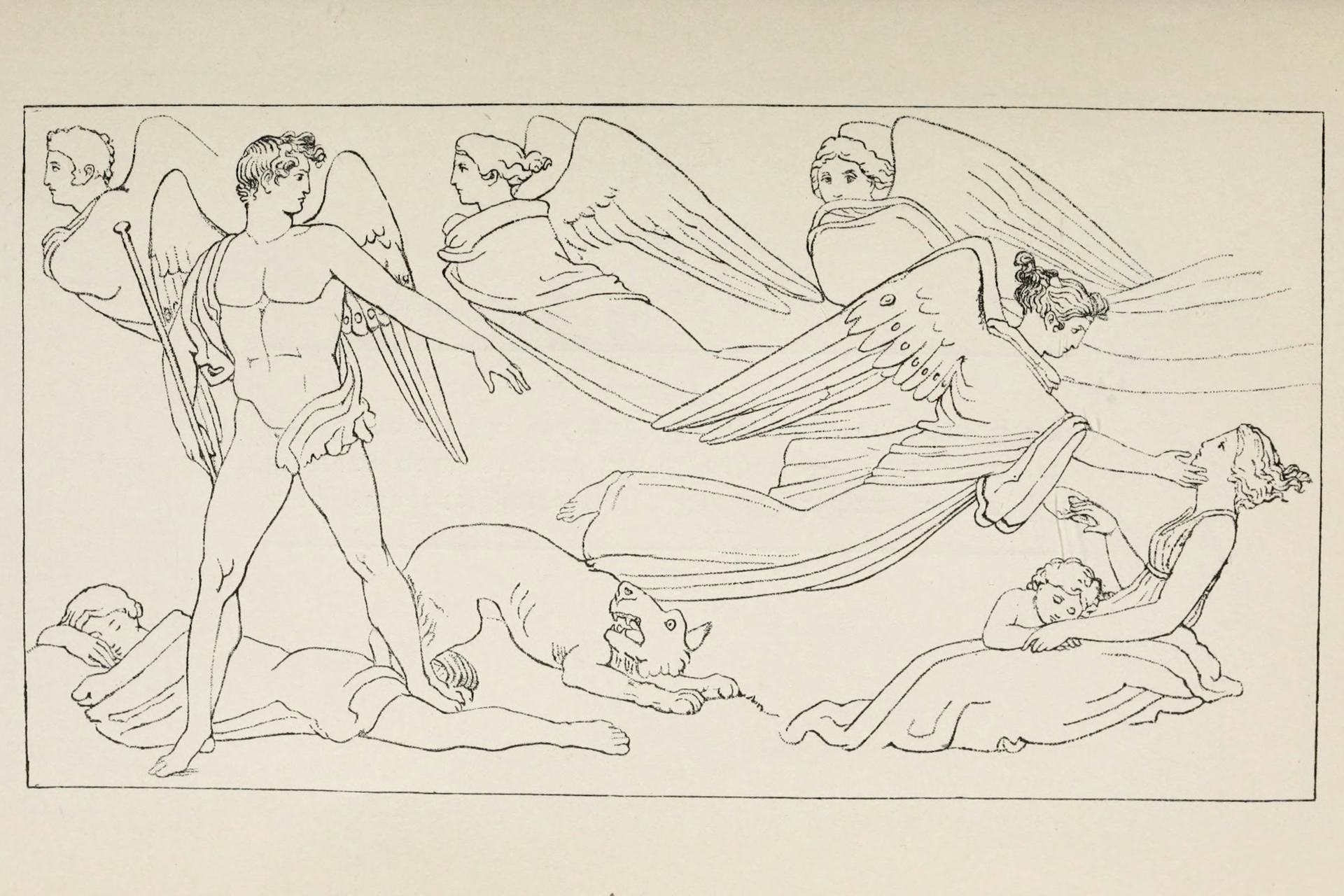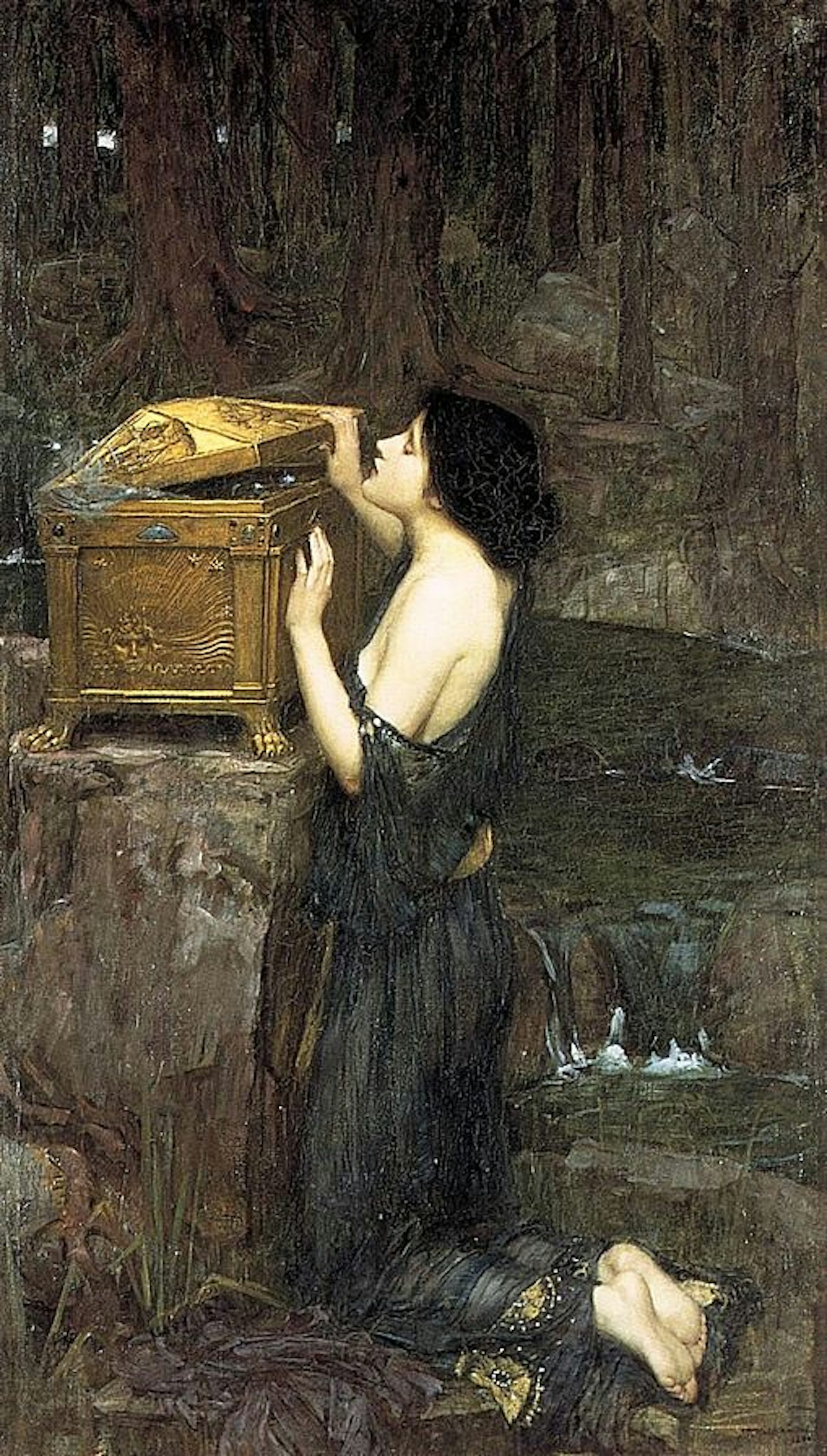Daemons

Illustration showing the souls of Hesiod’s Golden Race as daemons, by John Flaxman (1755–1826). From Ernst Beutler (ed.), John Flaxman’s Zeichnungen zu Sagen des klassischen Altertums (Leipzig: Insel, 1910)
Archive.orgPublic DomainOverview
The world of Greek religion and mythology included beings whose exact relationship to gods and mortals is difficult to define. Such beings were most commonly called “daemons,” a broad term that encompasses various creatures with various functions. Daemons existed alongside other supernatural or divine beings that were sometimes described as “spirits” or “phantoms.”
For the Greeks, daemons or spirits could be benevolent as well as malevolent. They were most commonly linked with misfortune and the allotment of destiny, but their roles were never strictly defined. Some daemons were associated with the souls of the dead or with divine forces that acted as intermediaries between humans and gods. But other supernatural beings of Greek lore were more similar to demonic spirits or evil, inhuman creatures.
Though ubiquitous in Greek popular belief, daemons and spirits had virtually no mythology. Nor were they generally worshipped in traditional cult, the way the gods were worshipped. Instead, they were most familiar from tall tales and folklore, where they appeared as strange and mysterious beings that haunted the many facets of everyday life.
Etymology
Etymologically, the term “daemon” (Greek δαίμων, translit. daímōn; pl. “daemones/daemons,” Greek δαίμονες, translit. daímones)—from which the English word “demon” is derived—is usually thought to come from the Greek verb δαίω (daíō), meaning “divide, distribute,” and ultimately from the Indo-European deh₂-(i-), meaning “cut, divide.”[1] This may reflect daemons’ connection with the allotment of destiny: in Greek mythology, every human life was imagined as a thread, which was cut once the preordained moment of death arrived.
Pronunciation
English
Greek
Daemon, daemons δαίμων (daímōn), δαίμονες (daímones) Phonetic
IPA
[DAHY-muhn], [DAHY-muhnz] /ˈdaɪ mən/, /ˈdaɪ mənz/
Attributes
Daemons
A daemon could be many things. In the most general sense (and as implied by the meaning of their name), daemons were regarded as divine beings who oversaw and doled out the destinies of human beings. They came to represent any change in fortune, good or bad, though they were mostly associated with misfortune and death.[2] But their nature, attributes, and significance also changed over time.
In the earliest Greek texts (the Homeric epics), daemons tended to represent any divine force that could not be precisely identified by mortals—generally a force influencing mental phenomena, such as delusion or insanity. [3]
At this early stage, daemons were broadly indistinguishable from the gods (even, sometimes, the Olympian gods) and from personified divine forces. Indeed, the words δαίμων (daímōn) and θεός (theós) functioned as synonyms throughout Greek history. But daemons, unlike gods, were almost never seen as “anthropomorphic,” or exhibiting human qualities; rather, they were unpredictable and impersonal forces that affected human life.
Over time, the concept of daemons expanded. For Hesiod, who lived not long after Homer, daemons were the souls of the dead—specifically, the souls of the original race of human beings, who had been fashioned from gold. This “Golden Age” had lived in peaceful bliss before dying out and being replaced, in succession, by the Silver Age, the Bronze Age, the Age of Heroes, and, finally, the wretched Iron Age.[4] These gentle spirits, writes Hesiod,
are kindly, delivering from harm, and guardians of mortal men; for they roam everywhere over the earth, clothed in mist and keep watch on judgements and cruel deeds, givers of wealth; for this royal right also they received.[5]
These ideas would be further developed by writers throughout the Classical period (490–323 BCE). During that era, authors continued to imagine daemons as the souls of the dead,[6] while adding that they could also be dreaded punishers of evildoers. In fact, daemons were sometimes equated with fearsome divine figures of vengeance, such as the Erinyes (the “Furies”)[7] or the Alastor.[8] Sometimes, these various ideas were combined: for instance, it was said that the soul of a person who had been murdered could take revenge upon their murderer.[9]
The concept of a “personal daemon,” which accompanied every human and gave them either good or evil fortune, was also fleshed out during the Classical period (though it was known even earlier).[10] Thus, a fortunate person was described as εὐδαίμων (eudaímōn), “having a good daemon,” while an unfortunate person was referred to as κακοδαίμων (kakodaímōn), “having a bad daemon.”
Over time, daemons were also increasingly viewed as distinct from the gods. For the philosopher Plato, a daemon was a divine being that each human possessed, and that acted as an intermediary between humans and gods.[11] Other philosophers, seemingly combining the Platonic daemon with earlier versions of the concept, made the daemon identical with the human soul.[12]
Xenocrates, a pupil of Plato, made the distinction between good and evil daemons;[13] this idea was adopted, in turn, by many religious and philosophical schools, including the Stoics and the Middle and New Platonists.
Eventually, all of these concepts would be adopted by the Christians, for whom daemons came to be defined exclusively as evil or harmful spirits—that is, “demons.”
Other Spirits
There were other spirits known to the ancient Greeks who were neither daemons nor gods, but who nonetheless had supernatural powers. They may have even been immortal; at the very least, they lived for a very long time, like nymphs. The Greeks did not have any single term for these beings; sometimes they called them εἴδολα (eídola) or φάσματα (phásmata), “phantoms.”
These “phantoms,” unlike daemons, were almost always evil or malevolent. They included beings such as Lamia and Mormo, “bogeywomen” known for eating children; the hideous Empusa; and the nightmare-inducing Ephialtes. The angry or restless souls of the dead (the so-called “ahoroi”) could also be included in this group. Hecate, as a goddess of the Underworld and all things relating to witchcraft and the dead, was sometimes viewed as their leader.
These phantoms—who were much more demonic than the daemons—were often imagined as having a physical form. They were almost always repulsive and were sometimes shown as half-human and half-animal. However, certain beings (including Lamia and Empusa) were said to have the ability to change their shape; they would take on the appearance of beautiful women to lure young men to their beds so they could devour them.
In addition to grotesque, spectral phantoms, some of the spirits that the Greeks feared were ancient personifications of various forces—forces such as the Keres (κῆρες/kêres), or “Dooms.” For Hesiod, it was Pandora, the first woman, who had released these Keres into the world of human beings when she opened her infamous jar and let them escape:
But the rest, countless plagues, wander amongst men; for earth is full of evils, and the sea is full. Of themselves diseases come upon men continually by day and by night, bringing mischief to mortals silently…[14]
Other spirits were not necessarily so sinister. The souls or ghosts of the dead, especially dead heroes (ἥρως/hḗrōs), could also be divine or semi-divine spirits. They could influence the world of the living, bringing either good or evil fortune. In some cases, these “heroes” could even do physical harm to the living.[15] Very often, they were also thought to possess prophetic powers.[16]

Pandora by John William Waterhouse (1896)
Wikimedia CommonsPublic DomainWorship
Daemons and spirits were not usually worshipped by the Greeks, at least not in the same way as gods. Only one such being, the daemon known as the Agathos Daemon (“Good Daemon”), was honored in traditional cult: in sanctuaries of Dionysus and during banquets, it was customary to pour the first libation of wine to the Agathos Daemon (who in iconography was represented as a snake).[17] In addition, the philosopher Socrates would sometimes make sacrifices to his personal daemon.
The more sinister spirits or “phantoms” were not worshipped in cult, though they were very important in popular belief. Various charms and amulets were believed to protect against them (not unlike the charms still used by some people today to protect against evil spirits). These spirits were sometimes also invoked in magic.
Pop Culture
Due in no small part to the influence of Christianity, the daemons and spirits of ancient Greek religion and myth usually appear in modern pop culture as frightful and malevolent demons. Phantoms such as Lamia and Empusa later became vampires and succubi in European folklore. When these mysterious beings appear in contemporary adaptations of Greek mythology, they are almost always associated with the dark world of monsters, witchcraft, and death.